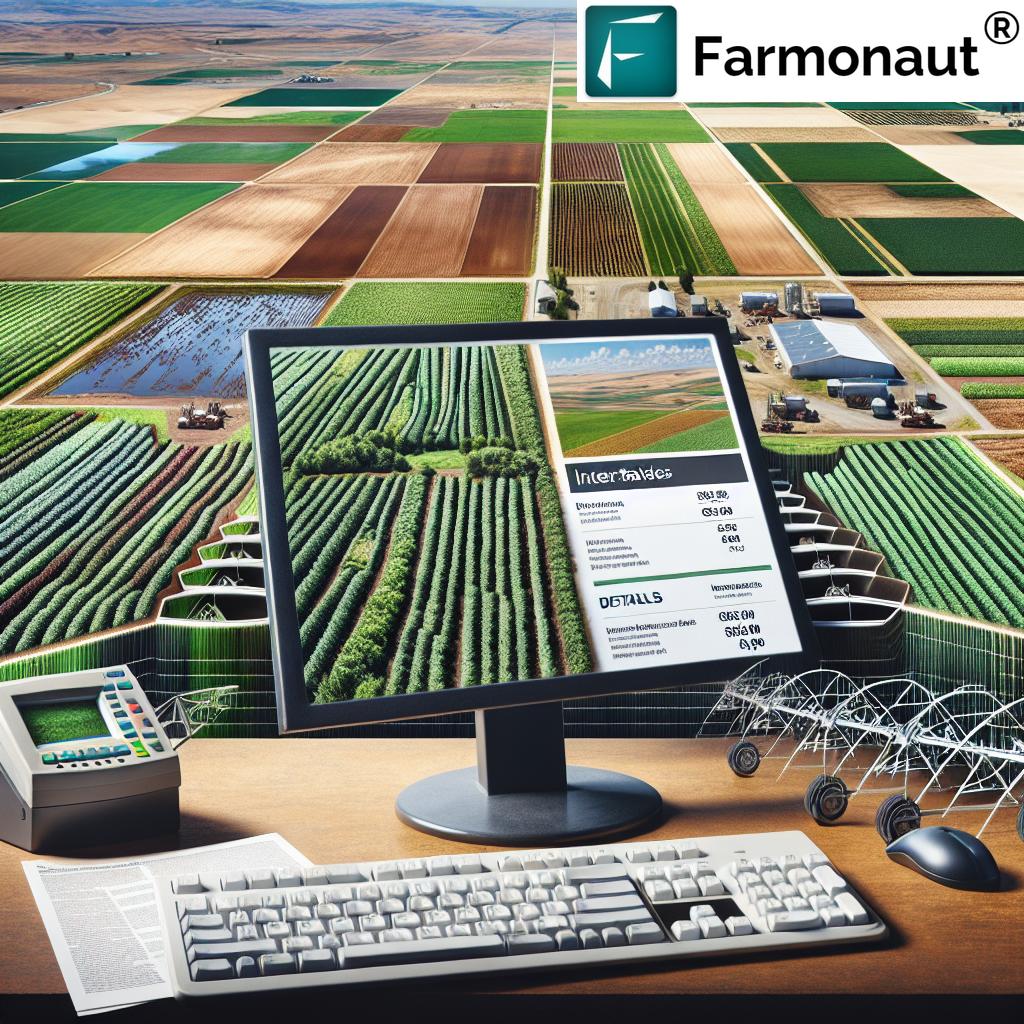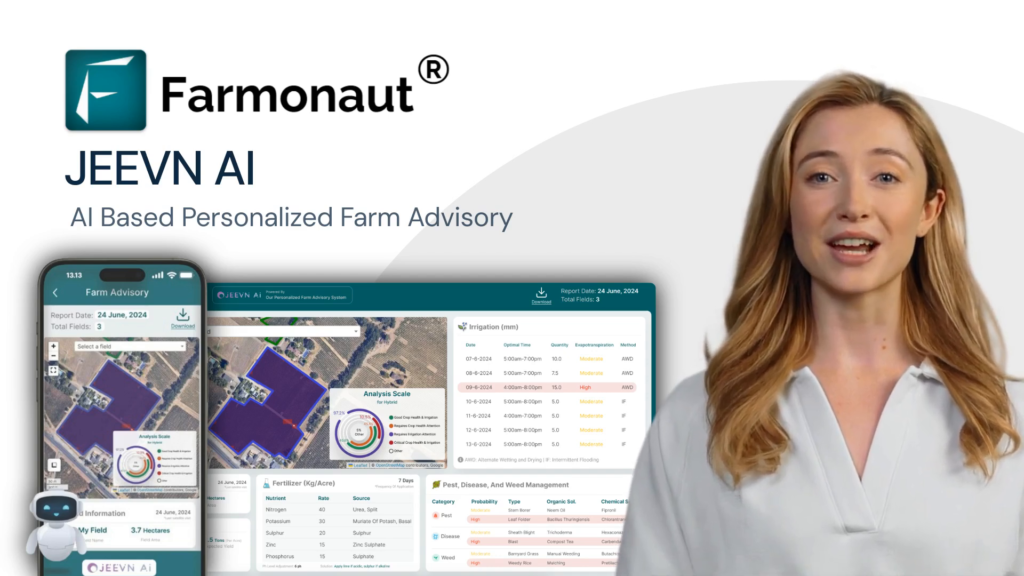USDA Announces New Farm Loan Rates: Essential Guide for Washington State Agricultural Producers
“USDA’s new farm loan rates range from 1.500% to 5.125%, offering diverse financing options for agricultural producers.”
We, at Farmonaut, understand the vital role that financial support plays in the success of agricultural operations. As a leading provider of satellite-based farm management solutions, we’re excited to share the latest updates on USDA farm loans and their implications for Washington State’s agricultural community. In this comprehensive guide, we’ll explore the new interest rates, various loan programs, and how these financial instruments can shape the future of farming in the United States.
Understanding the New USDA Farm Loan Rates
The United States Department of Agriculture’s Farm Service Agency (FSA) has recently announced updated interest rates for its agricultural loan programs. These rates, ranging from 1.500% to 5.125%, offer a spectrum of agricultural financing options designed to support farmers and ranchers across the nation. Let’s delve into the specifics of these USDA farm loans and how they can benefit Washington State producers.

Types of FSA Loan Programs Available
The FSA offers a variety of loan programs to meet the diverse needs of agricultural producers. Here’s an overview of the main types:
- Farm Operating Loans: These loans provide essential working capital for farm operations, including purchasing equipment, livestock, feed, seed, fuel, and other farm-related expenses.
- Farm Ownership Loans: Designed to help farmers and ranchers purchase or expand their agricultural land.
- Emergency Loans: Offer financial assistance to producers recovering from natural disasters or other emergencies.
- Conservation Loans: Support the implementation of conservation practices on farms and ranches.
- Microloans: Provide smaller, more accessible loans for beginning, niche, and small-scale operations.
Commodity Loan Rates and Farm Storage Facility Loans
In addition to the primary loan programs, the USDA also offers commodity loans and farm storage facility loans. These specialized financing options cater to specific needs within the agricultural sector:
- Commodity Loans: These loans allow producers to use their harvested commodities as collateral, providing short-term financing to meet cash flow needs.
- Farm Storage Facility Loans: These loans help farmers build or upgrade farm storage and handling facilities, crucial for maintaining crop quality and maximizing market opportunities.
At Farmonaut, we recognize the importance of proper storage and handling of agricultural products. Our satellite-based crop health monitoring can help farmers make informed decisions about when to store or sell their commodities, complementing the financial support provided by these USDA programs.
Agricultural Loan Interest Rates: What Washington State Farmers Need to Know
The new USDA farm loan rates offer competitive financing options for Washington State agricultural producers. Here’s a breakdown of the current interest rates for various loan programs:
| Loan Program Name | Interest Rate (%) | Loan Purpose | Eligibility Criteria | Maximum Loan Amount |
|---|---|---|---|---|
| Farm Operating Loans (Direct) | 3.875% | Working capital for farm operations | Active farmers, U.S. citizens | $400,000 |
| Farm Ownership Loans (Direct) | 4.125% | Purchase or expand farmland | Farm experience, unable to obtain commercial credit | $600,000 |
| Emergency Loans | 3.750% | Recovery from natural disasters | Disaster-affected farmers | Based on losses, up to $500,000 |
| Microloans | 3.875% | Small-scale and niche operations | Beginning farmers, small operations | $50,000 |
| Conservation Loans | 4.750% | Implement conservation practices | Farmers implementing NRCS-approved practices | $1,750,000 |
These rates are subject to change, so we recommend checking with your local FSA office for the most up-to-date information.
How These Loans Support Washington State Agriculture
Washington State’s diverse agricultural landscape, from the apple orchards of Yakima Valley to the wheat fields of the Palouse, can greatly benefit from these USDA farm loans. Here’s how:
- Crop Diversification: Operating loans can help farmers invest in new crop varieties, reducing risk and potentially increasing profits.
- Irrigation Improvements: Ownership loans may be used to upgrade irrigation systems, crucial in Washington’s varied climate zones.
- Disaster Resilience: Emergency loans provide a safety net for farmers affected by droughts, floods, or other natural disasters.
- Sustainable Practices: Conservation loans support the implementation of environmentally friendly farming methods, aligning with Washington’s commitment to sustainability.
At Farmonaut, we offer tools that complement these financial resources. Our satellite-based crop health monitoring and AI-driven advisory systems can help farmers make the most of their loans by optimizing resource allocation and improving crop yields.

Navigating the Farm Loan Application Process
Applying for USDA farm loans has become more accessible thanks to recent improvements in the application process. Here’s what Washington State producers need to know:
- Determine Eligibility: Review the specific requirements for each loan program to ensure you qualify.
- Gather Documentation: Prepare financial statements, tax returns, and farm production history.
- Contact Your Local FSA Office: Schedule an appointment to discuss your loan options and begin the application process.
- Complete the Application: Fill out the necessary forms, which can now be done online through the FSA’s new digital tools.
- Submit and Wait for Approval: Once your application is submitted, the FSA will review it and make a decision.
To streamline this process, the FSA has introduced online tools that enhance accessibility and reduce paperwork. These digital solutions align with our mission at Farmonaut to make agricultural technology more accessible to farmers worldwide.
Maximizing the Impact of Your USDA Farm Loan
Securing a USDA farm loan is just the first step. To maximize its impact on your agricultural operation, consider these strategies:
- Invest in Precision Agriculture: Use loan funds to adopt technologies that improve efficiency and yield. Farmonaut’s satellite-based solutions can help you make data-driven decisions about crop management.
- Diversify Your Operation: Consider expanding into new crops or livestock to spread risk and increase income potential.
- Upgrade Infrastructure: Invest in modern equipment or facilities that can increase productivity and reduce long-term costs.
- Implement Conservation Practices: Use conservation loans to adopt sustainable farming methods that can improve soil health and water efficiency.
- Plan for the Future: Use the financial stability provided by these loans to develop long-term strategies for your farm’s growth and succession.
“The USDA Farm Service Agency provides various loan programs, including operating, ownership, and emergency assistance for farmers and ranchers.”
The Role of Technology in Modern Farm Financing
As agricultural financing evolves, technology plays an increasingly important role in both securing and utilizing farm loans effectively. At Farmonaut, we’re at the forefront of this technological revolution in agriculture. Here’s how our solutions can complement USDA farm loans:
- Crop Health Monitoring: Our satellite-based monitoring helps farmers track crop health in real-time, ensuring that loan-funded investments in crops are protected and optimized.
- Resource Management: Farmonaut’s AI-driven advisory system can help farmers make informed decisions about resource allocation, maximizing the impact of their loan funds.
- Risk Mitigation: By providing early detection of crop stress or disease, our technology can help farmers take proactive measures, potentially reducing the need for emergency loans.
- Yield Forecasting: Accurate yield predictions can assist farmers in financial planning and loan repayment strategies.
To learn more about how Farmonaut can support your agricultural operations, visit our web app or download our mobile app:
The Future of Agricultural Financing in Washington State
As we look to the future, the landscape of agricultural financing in Washington State is likely to evolve. Here are some trends we anticipate:
- Increased Integration of Technology: Loan applications and management may become more streamlined through digital platforms.
- Focus on Sustainable Agriculture: More loan programs may be introduced to support environmentally friendly farming practices.
- Adaptation to Climate Change: Financing options may expand to help farmers invest in climate-resilient technologies and practices.
- Support for Diversification: Loans may increasingly support farmers looking to diversify their operations, including value-added products or agritourism.
At Farmonaut, we’re committed to supporting these trends through our innovative agricultural technologies. For developers interested in integrating our solutions, check out our API and API Developer Docs.
Frequently Asked Questions
Q: Who is eligible for USDA farm loans?
A: Eligibility varies by loan program but generally includes active farmers and ranchers who are U.S. citizens or qualified aliens. Some programs are specifically designed for beginning farmers or socially disadvantaged groups.
Q: How long does the loan application process take?
A: The timeline can vary depending on the loan type and individual circumstances. Generally, it can take anywhere from 30 to 60 days from application to approval.
Q: Can I use a USDA farm loan to purchase land in Washington State?
A: Yes, Farm Ownership Loans are specifically designed to help farmers and ranchers purchase or expand their agricultural land.
Q: Are there special loan programs for organic farmers in Washington?
A: While there isn’t a specific loan program for organic farmers, many USDA loan programs can be used to support organic farming operations. Additionally, the FSA offers Organic Certification Cost Share Programs.
Q: How can Farmonaut’s technology help me manage my farm loan more effectively?
A: Farmonaut’s satellite-based crop monitoring and AI advisory systems can help you optimize resource allocation, improve crop yields, and make data-driven decisions. This can lead to more efficient use of loan funds and potentially improve your ability to repay the loan.
Conclusion: Empowering Washington State’s Agricultural Future
The new USDA farm loan rates and programs offer a wealth of opportunities for Washington State’s agricultural producers. By leveraging these financial tools alongside modern agricultural technologies like those offered by Farmonaut, farmers and ranchers can position themselves for success in an ever-changing agricultural landscape.
We encourage all agricultural producers in Washington State to explore these loan options and consider how they can be used in conjunction with precision agriculture technologies to drive growth, sustainability, and profitability. Remember, the future of farming lies at the intersection of financial support and technological innovation.
To learn more about how Farmonaut can support your agricultural operations and complement your use of USDA farm loans, visit our website or contact us today. Together, we can cultivate a thriving future for Washington State agriculture.
Explore Farmonaut’s Subscription Plans
By combining USDA farm loans with Farmonaut’s cutting-edge agricultural technology, Washington State farmers can unlock new levels of productivity and sustainability. Start your journey towards smarter, more efficient farming today!















